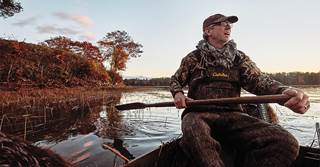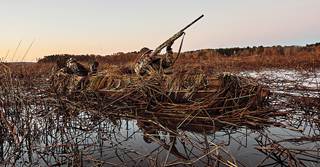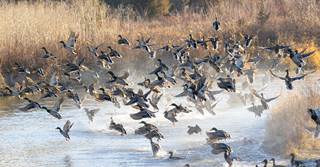Modern-Day Waterman
On Maine's Merrymeeting Bay, boat-builder and decoy-carver Frank Middleton has immersed himself in the customs and traditions that define this unique region
On Maine's Merrymeeting Bay, boat-builder and decoy-carver Frank Middleton has immersed himself in the customs and traditions that define this unique region

Photography by Peter Frank Edwards
The boat is narrow, but this marsh channel-called a "guzzle" in Maine parlance-is narrower still, and the wild rice and bulrush hiss along the wooden sides of the skiff with the sound of ocean surf. I'm lying nearly flat in the bottom of the boat, my eyes barely peeking over its slender, pointed bow. Behind me, Frank Middleton is hunkered down as well, working a single sculling oar through the shallow waters of a rising Kennebec River tide. The oar is about six-and-a-half-feet long, hand-carved and smoothed with hard use, and it exits the boat through a brass-lined port in the transom. Using a deft fluttering motion, Middleton can move this lanceolate slip of a boat almost imperceptibly through the marsh. Which is the point.
We knife deep into the reeds, twisting through the wild rice. Closing the distance, it's hard not to think of the old ways, of the old market gunners working the East Coast tides in their punt gun skiffs and sink boxes. Of the way duck hunting used to be.
"About 60 yards ahead," Middleton whispers. "Shoot when it feels right."

Middleton leads a throwback existence along the Maine coast, creating stunning hand-carved decoys and refinishing classic gunning "floats" that he employs in pursuit of ducks among the area's vast tidal marshes.
Photo © Peter Frank Edwards
And then I see them: A stippling of dark duck heads erect in the marsh. Four, then a dozen, then twice that number. Middleton gives the sculling oar a hard flutter to push the boat through the reeds and suddenly the marsh erupts in ducks-the birds we've seen and more that we haven't, 60 mallards and black ducks rising in a great chaos of wing beats and clattering grass and quacks.
They are so close. To the left and right and straight ahead, more ducks than I thought, more ducks than I imagined. When I rise to shoot, I track a mallard drake at 15 feet but don't shoot. It's too close. But I find another, and another, and pick the birds out from a riot of wings and orange feet and green heads and they fall close as the air erupts in the bedlam of the flush.
Middleton and I sit up straight to watch the flock fleeing wildly over the broad silver bay. "Maybe now you understand what I've been telling you," he grins. "With this boat you make your own luck. No sitting around waiting. I don't think there's a more exciting way to hunt ducks."

Photo © Peter Frank Edwards
And he's right about his boat. Most duck boats are conveyances whose function is to get you where you want to be-to the blind, to the slough, to the marshy point across the sound. Some duck boats pull double duty as a blind, but those are typically bulky, inelegant solutions to the problem of staying hidden. Not so Middleton's craft, called a Merrymeeting Bay gunning float. From a bird's perspective it is innocuous as a marsh lump. But when oared and poled by a skillful sculler, and deployed by a hunter with a deep understanding of tides and how they affect the ducks, it is the stealth bomber of the rice marshes.
And boy, does it work.
"I don't know, Frank," I respond. "That was sort of fun, I guess. Let's do it again to see if I really like it."
Just north of Bath, Maine, six rivers come together to form Merrymeeting Bay: The Kennebec, Androscoggin, Eastern, Abagadasset, Muddy, and Cathance. The inland delta sprawls like a Rorschach blot, a large mosaic of open water, marsh creek, marsh pond, and marsh-fringed sloughs that are close enough to the sea that the tides can rise and fall five feet.
Which means that Merrymeeting Bay is a place where ducks have a lot of choices. The twice-daily ablution of the tides keeps birds moving from place to place-from flooded rice marshes to tree-lined feeder creeks to open water and back again. Duck hunting here is similarly tied to the rise and fall of water. "With the tides, the birds move almost constantly during the day," Middleton says. "That's part of the evolution of these boats and the genesis of this kind of hunting."

Photo © Peter Frank Edwards
The Merrymeeting Bay gunning float, or simply "float," as it's called in the region, is a boat conjured up and crafted for a very specific piece of water, in similar fashion to the better-known Barnegat Bay sneakbox or the Chamberlain gunning dory. The best-known and most highly sought Merrymeeting floats were made by a local named Buster Prout, who constructed his first gunning float in 1960 and is known to have built only 17 of the craft. Some 16 feet long, these "Busters" have a telltale sculling port near the transom waterline, and they can accommodate a small outboard motor, which enables hunters to move around on the bay's open waters. "Everything is bent, beveled, tapered, and faired to a fare-thee-well," wrote Bowdoin College English Professor and Merrymeeting Bay gunning float enthusiast Frank Burroughs. Every aspect of the boat is tuned for slipping through a flooded marsh or being poled across the matted vegetation when the water goes seaward. Every element of the boat seems rooted in this very specific place.
So it might seem odd that one of the gunning float's most ardent fans, and perhaps the finest modern practitioner of the art of using one, is a relative newcomer to Merrymeeting Bay. But then, Frank Middleton's own life and career haven't exactly followed a plumb line.
Born and raised in the South Carolina Low-country, Middleton graduated from North Carolina's Guilford College with a degree in geology in 1998, pulled a stint working construction in Montana, and in 2002 moved back south to Wadmalaw Island, South Carolina, just outside of Charleston. There, he opened a custom boat-building company specializing in wooden boats and custom cold-molded sportfishing yachts. Middleton Boatworks is still the name of the business, although the transition from gleaming new million-dollar fiberglass fishing craft to hand-crafted gunning floats is nearly complete.
In 2012, Middleton and his family moved to Maine, where he makes a living as a carpenter, restores historic Maine watercraft, and carves waterfowl decoys and other birdlife. He had been a frequent visitor to Maine-and an aficionado of Merrymeeting Bay duck hunting-since a visit with his brother at Bowdoin College in 1999. Early on he fell under the spell of the old gunning floats but couldn't afford a genuine Buster Prout-built boat, he says. Soon after moving, however, he stumbled across a used Merrymeeting Bay gunning float for sale in a local shopper called Uncle Henry's. He bought it. "It was covered in canvas that looked like it had been adhered with toothpaste," Middleton says, smiling at the memory. "I figure it was from the 1940s. It was all strip-planked and really cobbled together. These boats hibernate in somebody's barn or flipped over in the backyard for all but two months of the year. You rarely see one in pristine condition."
He stripped that first boat and glassed the exterior, leaving the interior and its hard-won patina intact. He hunted it hard, and then restored another. When a genuine Buster came up for sale-the 17th and last of Prout's boats-he bought it. "That was a once-in-a-lifetime thing," he says.

Photo © Peter Frank Edwards
Another stunning Maine sunrise, another cycle of incoming tide-"a feeding tide," in Middleton's terms. We're back in the Merry-meeting Bay marsh. We've spent an hour hunting over Middleton's hand-carved decoys, using the gunning float as a blind, but not long after the sun is over the trees, he's nervous as a cat, ready to go. The active, spot-and-stalk manner of hunting from a gunning float suits his personality. We spot a half-dozen ducks landing deep in the reeds, and the predatory uptick in Middleton's pulse is palpable.
"See them?" he asks, already scrunching down low in the boat. "Now we know the play. Now we take the fight to the ducks."
We ditch the decoys and he gooses the gunning float with 10 short, quick strokes on the sculling oar, then settles into a pulsing rhythm to cross the bay and slip into a guzzle a few hundred yards from the ducks. We worm through the creek like a rat snake hunting mice in the brambles, twisting and turning, stealthy and silent. It's not unlike the time-honored tradition of tracking big-woods bucks in deep Maine snow.
He may not be a native Mainer, but Middleton has found his place in these big waters and woods. Long days in the shop carving decoys and planing boat strakes alternate with long days in the grouse woods and rice marshes. It's a hand-crafted sort of existence, one that responds to challenge with a focused determination, like carving around a hard knot. In a college sculpture class, his professor openly dismissed Middleton's initial attempts to carve birds. "His perspective was that decoy carving wasn't art," he says. The incident remains kind of a marker for Middleton's journey as an artist. Then, during his boat-building days in South Carolina, he befriended local decoy maker Tom Boozer, who lived nearby and lit the carving fire again. "My overall craftsmanship had evolved by that point," Middleton recalls. "I could build a piece of furniture. I could build a boat and put an engine in it, handle all the electrical systems, fuel systems, water systems. I thought, Surely I can take a block of wood and make it happen. Little did I know."
Now he takes very few things for granted, including success. His first birds, he says, were "terrible." He keeps them atop a cabinet in his workshop, a sort of totem to remind him that art, as life, is marked by journey.
Late one morning, after my turn with Middleton and the gunning float, I sit on a tall bluff overlooking the bay, binoculars in hand, searching for movement. Middleton and photographer Peter Frank Edwards are in the float, somewhere on the far side of a broad rice marsh that had been sucking ducks from the sky. While sculling for ducks the traditional way is an intimate and personal pursuit, my vantage point helps me appreciate how these boats, and this way of hunting, almost fully integrate into the larger landscape of Merrymeeting Bay.
I watch the boat turn up a guzzle, and I have an inkling of what they're in for. From a distance, Middleton and Edwards look like tiny stick figures, but at 10X magnification I can see it all come together. I spot a single mallard hen flapping her wings, and I know there might be 30 ducks hidden nearby. The tide is high, higher than Middleton likes it, and the vegetation is becoming scarcer by the moment. The float closes in on the ducks, and I know it's a fraught move. With the flooding tide, every little movement of the sculling oar sends ripples of disturbance far ahead. The ducks begin to gather together, nervous and alert, and I know the game is almost over as Middleton goes for it, juicing the boat with strong flutter strokes to rush the birds.

Photo © DonaldMJones.com
I see Edwards rise and shoot, and it takes another second for the shotgun report to reach me, rolling over a half-mile of marsh and open water. Edwards rises from the supine stalking position to look for downed birds as Middleton's Deutsch-Drahthaar, Haley, launches from amidships in the gunning float. It's a sure sign of ducks on the water, but by then I know that Middleton has done it again-pulled it all together in the Maine wilds, the past and present, the old ways and the new, as if he'd shaped them all by hand.
Ducks Unlimited uses cookies to enhance your browsing experience, optimize site functionality, analyze traffic, and deliver personalized advertising through third parties. By continuing to use this site, you agree to our use of cookies. View Privacy Policy